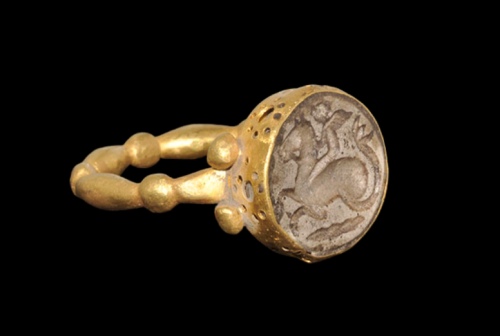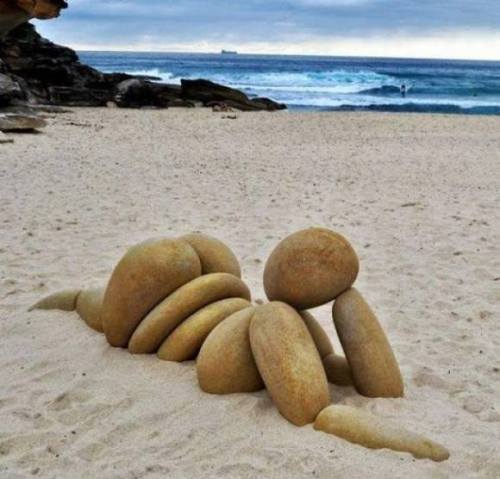#TlalocTuesday

#TlalocTuesday
Serpentine Rain God Mask
Mixtec. Mexico. 13th to 14th century
Many peoples in ancient Mexico made masks of different types and in a variety of materials. Some depict idealized human faces, others animals or supernatural beings. How the masks functioned is not always clear. Only a few have been discovered in archaeological contexts and life-uses are hard to make out. Face-size examples with holes for eyes and mouth were presumably worn in processions or on ceremonial occasions. Masks with no such openings may have been laid upon the dead; or they might have been tied to statuary or deity bundles, as the holes on the sides of the forehead of this mask suggest. Still others are small enough to be worn as pendants or as part of headdresses. This mask, carved from a light green serpentine, depicts the rain god Tlaloc with the characteristic ringed eyes, prominent teeth, and a mouth with an upper lip-moustache that curls on each side. He also wears a nose bar in the nasal septum.
The Met
More Posts from Templejewelry-blog and Others


Ancient Greek gold ring with a stone intaglio of a hippocampus, dated to the 5th to 3rd centuries BCE.
Most of those fish come from the Green River formation in Wyoming - a desert lake that would fill and dry up. Some Mosasaur teeth in the final photo.


3/4″ Imperial jasper set!
This sample is remarkable. Original caption:
fms.fossils This is a shot of the abdomen of a near-perfect ichthyosaur I found at Lyme Regis last year. This one is so well preserved that much of the skin pigment and stomach contents are still preserved across the animal. This exceptional level of preservation is rare in the fossil record, and Lyme Regis is one of the few places where it can be found. Exceptional fossil locations where soft tissues can be found are known as Lagerstätten (singular Lagerstätte), or technically Konservat-Lagerstätten. This is from the German meaning ‘storage place’ and there are not many of them known in the world. While Lyme Regis is often forgotten as a fossil site of exceptional preservation, I would argue that it is one of the best, right up there with the more famous Chinese Lagerstätte deposits. With the advent of modern preparation techniques and expert preparators, the fossils from Lyme Regis are showing how well preserved they can be and the soft tissues have the potential to tell us a great deal about how the animals of the Early Jurassic seas lived.


Adamite in Limonite pocket - Ojuela Mine, Mapimi, Durango, Mexico

Lapis Lazuli Teardrops and Labret by Temple Jewelry

Something About Crush From Finding Nemo

1/2″ Sodalite with aegririne. This material is super cool! The black parts (the aegririne) has a silver shine almost like labradorite. The flash isn’t exactly the same but it’s there!

Can you believe this petrified wood?! These jammers are 1 1/4″.

Rock bottom
-
 mauriboy liked this · 7 years ago
mauriboy liked this · 7 years ago -
 vivienne-not-viv-blog liked this · 7 years ago
vivienne-not-viv-blog liked this · 7 years ago -
 swipedgraff reblogged this · 8 years ago
swipedgraff reblogged this · 8 years ago -
 spiritualadventure1 reblogged this · 8 years ago
spiritualadventure1 reblogged this · 8 years ago -
 derpyyandere-blog liked this · 8 years ago
derpyyandere-blog liked this · 8 years ago -
 sictransitgloriamvndi liked this · 8 years ago
sictransitgloriamvndi liked this · 8 years ago -
 ishiganto liked this · 8 years ago
ishiganto liked this · 8 years ago -
 bloodedcelt reblogged this · 8 years ago
bloodedcelt reblogged this · 8 years ago -
 ludmila199 liked this · 8 years ago
ludmila199 liked this · 8 years ago -
 collectivesighs reblogged this · 8 years ago
collectivesighs reblogged this · 8 years ago -
 collectivesighs liked this · 8 years ago
collectivesighs liked this · 8 years ago -
 knowledgeistreasure reblogged this · 8 years ago
knowledgeistreasure reblogged this · 8 years ago -
 greg-worms liked this · 8 years ago
greg-worms liked this · 8 years ago -
 sherlocks-blue-scarf liked this · 8 years ago
sherlocks-blue-scarf liked this · 8 years ago -
 gnostix1 liked this · 8 years ago
gnostix1 liked this · 8 years ago -
 eonjaw liked this · 8 years ago
eonjaw liked this · 8 years ago -
 majosepoe liked this · 8 years ago
majosepoe liked this · 8 years ago -
 theoldthirdjm liked this · 8 years ago
theoldthirdjm liked this · 8 years ago -
 pumayeh-blog liked this · 8 years ago
pumayeh-blog liked this · 8 years ago -
 crowwarlock23 liked this · 8 years ago
crowwarlock23 liked this · 8 years ago -
 kohdiphoto liked this · 8 years ago
kohdiphoto liked this · 8 years ago -
 bloodedcelt liked this · 8 years ago
bloodedcelt liked this · 8 years ago -
 the-ancient-knowledge reblogged this · 8 years ago
the-ancient-knowledge reblogged this · 8 years ago -
 the-ancient-knowledge liked this · 8 years ago
the-ancient-knowledge liked this · 8 years ago -
 aleveex liked this · 8 years ago
aleveex liked this · 8 years ago -
 artfromthefuture reblogged this · 8 years ago
artfromthefuture reblogged this · 8 years ago -
 andytheprof liked this · 8 years ago
andytheprof liked this · 8 years ago -
 antireason liked this · 8 years ago
antireason liked this · 8 years ago -
 cloud721 liked this · 8 years ago
cloud721 liked this · 8 years ago -
 penig liked this · 8 years ago
penig liked this · 8 years ago -
 natalunasans liked this · 8 years ago
natalunasans liked this · 8 years ago -
 theegoist liked this · 8 years ago
theegoist liked this · 8 years ago -
 blackgoldfish33 reblogged this · 8 years ago
blackgoldfish33 reblogged this · 8 years ago -
 littleladylynx liked this · 8 years ago
littleladylynx liked this · 8 years ago -
 obeahdear liked this · 8 years ago
obeahdear liked this · 8 years ago -
 templejewelry-blog reblogged this · 8 years ago
templejewelry-blog reblogged this · 8 years ago -
 templejewelry-blog liked this · 8 years ago
templejewelry-blog liked this · 8 years ago